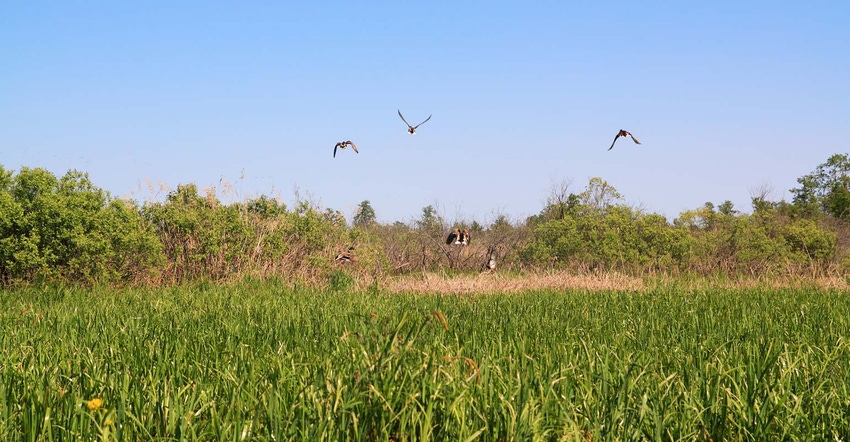
Illinois Farm Bureau published a story this week describing a young farmer and his wife with land that was a wetland, according to USDA’s Natural Resources Conservation Service (NRCS). The story indicates the young farmer lost his case because he could not prove his land was farmed prior to Dec. 23, 1985 when Swampbuster became effective. NRCS convinced a National Appeals Division (NAD) judge wetlands had been disturbed and were being farmed.
Another story involved a farmer who also happened to be a lawyer. Apparently NRCS attempted to show his farm had wetlands three times, and NRCS lost every time. An NRCS delineator had been on both sites for a visit and determined there were wetlands on both farms.
NRCS delineators cannot make just one visit and make such a determination. NRCS staff must follow very strict rules in determining what is or is not a wetland on a farmer’s property.
The Food Security Act of 1985 allowed USDA to develop wetland procedures to determine if farmland had been farmed before or after Dec. 23, 1985. Most farmers are unaware that NRCS staff must follow precise procedures and rules set forth in the National Food Security Act Manual 5thedition (NFSAM). It has a subpart known as Wetland Identification Procedures 2010.
In addition to the procedures document, NRCS personnel are directed to follow a Corps of Engineers’ Regional Supplement Manual. For most regions, this is a 150-plus page document. It even has a specific section dealing with farmland that was brought into production after Dec. 23, 1985.
A final document identified as the 1987 Corps of Engineers’ Wetlands Delineation Manual must also be followed by NRCS delineators. The Illinois Farm Bureau news story was unclear as to whether the NRCS delineator in the Illinois cases followed any of the appropriate procedures.
There are three manuals that require a wetland to have positive evidence of hydric soils, hydrophytic vegetation, and wetland hydrology. As a farmer, you must make sure that the NRCS delineator is competent, because your private property rights are at stake.
Why the 1985 farm bill discouraged wetland conversion
The Food Security Act of 1985 was designed to discourage converting wetlands into non-wetlands for crop production. Congress was using sleight of hand to take farmland out of production in order to decrease productive acres. NRCS delineators are quite vigorous and aggressive in claiming lots of land is wetland when it is not. (Less land, then less production and higher prices.)
All lands that are determined to be wetlands must have a predominance of hydric soils– permanently or seasonally saturated by water. Second, to be a wetland, your farm land needs to be inundated or saturated by surface or groundwater sufficient to support a prevalence of hydrophytic or water loving vegetation. Finally, your property must have a prevalence of hydrophytic vegetation. There is another 300-page document that defines hydrophytic vegetation.
NRCS’s own Wetland Identification Procedure document calls the situation where land has been cleared “atypical”. It is particularly important for farmers to know when their tile was installed because one trick NRCS uses is to never tell you that hydrologic alterations occurring PRIOR to December 23, 1985 are grandfathered in. Meaning, the water table has been lowered naturally!
There are very specific steps an NRCS delineator must undertake in an evaluation. Hydric soils are very tricky to determine. Most counties have a soil survey which will show whether soil on a farmer’s property is hydric or nonhydric. The U.S. Geological Survey also has excellent maps for use in identifying wetlands on farm land.
Regarding hydrophytic vegetation, a farm generally does not have such original vegetation so a comparison site must be found. A comparison site must meet stringent analytical requirements. One item NRCS delineators generally fail to undertake is sufficient direct hydrologic observations. Most Corps Regional Manuals require a NRCS delineator to visit a farm potential wetland several times during the growing season. Most delineators seem to ignore that for farmland or timberland. To be a wetland, there must be water standing on the land for at least seven days and that the subsoil down 12-14 inches must be fully saturated for 14 or more consecutive days.
It is hard to understand how an NRCS delineator, based on one site visit, can tell any farmer he is in violation of the NRCS Swampbuster rules. Illinois Farm Bureau needs your support in amending the Swampbuster rules. Your farm could be next to have NRCS tell you that you have wetlands. NRCS visits approximately 6,000 farms a year.
The opinions of the author are not necessarily those of Farm Futures or Farm Progress.
About the Author(s)
You May Also Like




